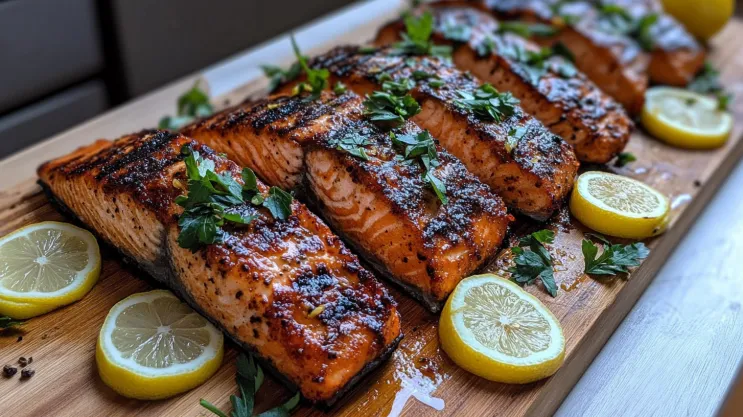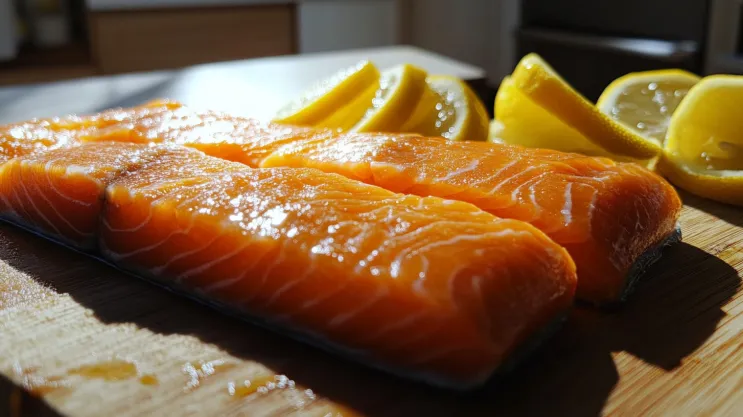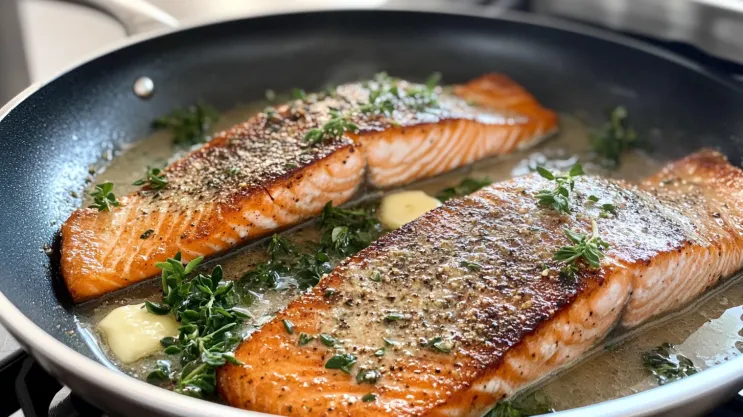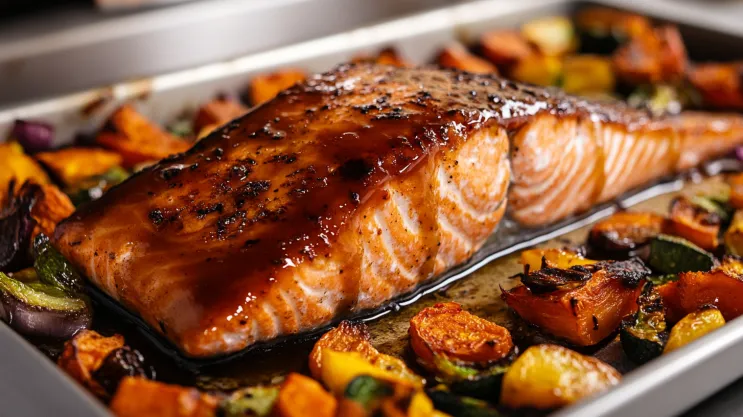
When it comes to cooking salmon, not all types are created equal. Coho salmon, also known as “silver salmon,” has a unique flavor and texture that deserve a little extra attention. If you’ve ever wondered, “Do I need to cook coho salmon differently?” – the answer is yes! But don’t worry, I’ve got you covered with all the tips, tricks, and tasty recipes to make your coho salmon shine.
Table of Contents:
- Mild, Sweet, and Versatile: What to Expect (H3)
- Why Coho’s Flavor Impacts Your Cooking Technique (H3)
Introduction:
Coho salmon is often called the “middle ground” of salmon varieties. It’s leaner than king salmon but more flavorful than sockeye. Because of its balanced taste and thinner fillets, coho requires a slightly different approach in the kitchen to bring out its best qualities.
What Makes Coho Salmon Unique?

Let’s start with what makes coho salmon stand out. It’s known for its bright silver skin, reddish-orange flesh, and mild, almost sweet flavor. Compared to richer varieties like king salmon, coho is light and delicate, making it a favorite for people who want a subtler fish taste.
But here’s the kicker: because coho has less fat, it can dry out quickly if you’re not careful. It’s like cooking a lean cut of chicken – you need to be mindful of heat and timing to keep it juicy.
“Coho salmon is like a well-crafted acoustic guitar – simple, elegant, and capable of incredible performance when handled with care.”
Key Differences Between Coho Salmon and Other Salmon Types
Not all salmon is the same, so it’s important to know what makes coho different:
- Fat Content: Coho salmon has less fat than king salmon, so it cooks faster.
- Texture: The flesh of coho is firm yet tender, which makes it versatile for various cooking methods.
- Size: Coho fillets are thinner and more uniform, which means you don’t have to worry about thick, uneven pieces cooking at different rates.
So, if you’re used to cooking fattier salmon types, you’ll need to adjust your technique when cooking coho. Don’t worry – we’ll get into all the methods that make coho salmon taste amazing.
Understanding the Flavor Profile of Coho Salmon
Mild, Sweet, and Versatile: What to Expect
If you’ve never tasted coho salmon, you’re in for a treat. It has a delicate, sweet flavor that pairs beautifully with a wide range of seasonings and sides. Unlike sockeye salmon, which has a strong, bold taste, coho is mild and works well for people who prefer subtler flavors.
Because it’s so versatile, coho salmon can take on the personality of whatever you cook it with. Lemon and herbs? Delicious. A smoky, maple glaze? Perfection.
Why Coho’s Flavor Impacts Your Cooking Technique
Here’s where things get interesting. Since coho salmon isn’t as oily as other types, it doesn’t need to be drowned in heavy sauces to taste good. In fact, lighter sauces and marinades let its natural sweetness shine through.
But be careful: its low-fat content means it’s more prone to drying out. You need to choose cooking methods that lock in moisture, like grilling with a cedar plank, pan-searing in butter, or poaching in broth.
“Think of coho salmon as a blank canvas – it’s up to you to paint it with bold, beautiful flavors without overcomplicating it.”
Popular Cooking Methods for Coho Salmon
There’s no one-size-fits-all approach when it comes to cooking coho salmon. Some methods bring out its crisp exterior, while others keep it soft and flaky. Here’s a breakdown of the top ways to cook coho salmon:
Pan-Searing for a Crisp Exterior

Pan-searing is a quick and easy way to get that golden, crispy crust while keeping the inside moist. Here’s how to do it:
- Preheat your pan: Medium-high heat is your friend.
- Add oil or butter: Make sure the pan is hot before adding the salmon.
- Place the fillet skin-side down: This prevents the delicate flesh from sticking.
- Cook for 3-4 minutes per side: Flip carefully and finish cooking until the salmon flakes easily with a fork.
For a rich twist, consider a Dijon glaze similar to those used in this chipotle steak recipe for tangy, smoky undertones.
Oven-Baking for an Even Cook
If you want an easier, hands-off method, try baking your coho salmon:
- Preheat your oven to 375°F (190°C).
- Place the salmon on a lined baking sheet and season with your favorite herbs and spices.
- Bake for 10-12 minutes or until the internal temperature reaches 125-130°F.
Looking for a side dish? Try this Greek omelette guide for a Mediterranean-inspired pairing.
Grilling for a Smoky Flavor
There’s something magical about grilling coho salmon. The charred edges and smoky aroma make it irresistible. To prevent it from sticking, grill the salmon on a cedar plank or oil the grates well.
- Preheat your grill to medium heat.
- Place the salmon skin-side down and grill for 6-8 minutes per side.
- Brush with a glaze like honey mustard or soy maple for extra flavor.
How Coho Salmon Cooks Differently Compared to Other Types
Coho salmon is a bit of a culinary chameleon. Its leaner, more delicate nature means you need to approach cooking with a bit of strategy. Let’s break down the key ways it behaves differently from other salmon types.
Lower Fat Content: What It Means for Cooking
Because coho salmon has less fat, it cooks much faster than richer varieties like king salmon. That’s great if you’re in a hurry, but it can also lead to a dry, disappointing fillet if you’re not careful.
Key takeaway: Keep an eye on your cooking time and temperature to avoid overcooking. Remember, salmon continues cooking even after you’ve taken it off the heat!
Thinner Fillets: How to Adjust Cooking Times
Coho fillets are typically thinner than their counterparts. This means they need less time in the oven, pan, or grill. For thick fillets like king salmon, you might bake for 15 minutes, but coho only needs 10–12 minutes to stay moist and flaky.
“Think of coho salmon like a fast runner – it gets to the finish line quickly, so don’t leave it unattended!”
Best Cooking Temperatures for Coho Salmon
For perfectly cooked coho salmon, aim for an internal temperature of 125–130°F (52–54°C) for medium-rare. If you prefer it more cooked, you can go up to 135°F. But beware – anything over that, and your salmon may become dry.
Common Problems When Cooking Coho Salmon (and How to Avoid Them)
Even the best chefs have run into issues when cooking salmon. But don’t worry – here are some common problems and foolproof solutions for cooking coho like a pro.
Problem: Dry, Overcooked Salmon
Coho salmon’s lower fat content makes it more prone to drying out. If your salmon feels more like jerky than a juicy fillet, it’s likely overcooked.
Solution:
- Use a meat thermometer to check the internal temperature.
- Consider basting with butter, olive oil, or a glaze to lock in moisture.
- Try cooking at a lower temperature for a longer time.
Pro Tip: After cooking, let your salmon rest for a minute or two before serving. This helps redistribute the juices and keeps it moist.
Problem: Sticking to the Pan or Grill
Nothing’s more frustrating than trying to flip a fillet and having it fall apart because it’s stuck to the surface.
Solution:
- Use a non-stick pan or season your grill grates with oil.
- Always cook the salmon skin-side down first to protect the delicate flesh.
- Avoid moving the fillet too soon – it will release from the pan naturally when it’s ready.
“Salmon is like a good guest – if you don’t rush it, it’ll leave the pan gracefully.”
Problem: Bland Flavor
Coho salmon’s mild taste can sometimes come across as bland if you don’t season it well.
Solution:
- Use flavorful marinades with ingredients like garlic, lemon, herbs, and soy sauce.
- For bold flavors, try a maple-mustard glaze or a spicy Cajun rub.
- Don’t forget to season with salt before cooking – it helps enhance the natural sweetness of the salmon.
Recipe Ideas for Cooking Coho Salmon
Now for the fun part – cooking! Here are a few mouth-watering recipe ideas that will make you fall in love with coho salmon.
Lemon Herb Butter Coho Salmon (Pan-Seared)
This classic dish highlights the natural flavors of the fish with just a few simple ingredients. The lemon butter sauce adds a rich, tangy finish.
Ingredients:
- 2 coho salmon fillets
- 2 tablespoons butter
- 1 lemon (sliced)
- Fresh parsley, salt, and pepper
Instructions:
- Heat the butter in a pan over medium-high heat.
- Add the salmon fillets skin-side down and cook for 3-4 minutes.
- Flip and cook for another 2-3 minutes.
- Squeeze lemon juice over the fillets and garnish with fresh parsley.
Maple Glazed Coho Salmon (Oven-Baked)

This sweet and savory recipe is perfect for an easy weeknight dinner. The maple glaze caramelizes beautifully in the oven.
Ingredients:
- 2 tablespoons maple syrup
- 1 tablespoon Dijon mustard
- 1 tablespoon soy sauce
- 2 coho salmon fillets
Instructions:
- Preheat the oven to 375°F (190°C).
- Whisk together the maple syrup, mustard, and soy sauce.
- Brush the glaze over the salmon fillets and place them on a lined baking sheet.
- Bake for 10-12 minutes until the salmon is flaky.
“A maple glaze turns coho salmon into a melt-in-your-mouth experience.”
Garlic-Dill Poached Coho Salmon
Poaching keeps the salmon moist and infuses it with subtle flavors. This garlic-dill version is light and perfect for pairing with a fresh salad.
Ingredients:
- 2 cups vegetable or chicken broth
- 1 lemon (sliced)
- 2 garlic cloves (smashed)
- 2 coho salmon fillets
- Fresh dill
Instructions:
- Bring the broth, lemon, and garlic to a simmer in a wide pan.
- Add the salmon fillets and simmer for 8-10 minutes until cooked through.
- Remove from the pan and sprinkle with fresh dill before serving.
Coho Salmon Pairings: Best Sides and Sauces
Cooking coho salmon is only half the fun – the right sides and sauces can elevate your dish to restaurant-level amazing. Whether you prefer something light and fresh or hearty and comforting, there’s a perfect pairing for you.
Fresh Veggies and Salads
Fresh vegetables and salads complement the mild flavor of coho salmon perfectly. Some top choices include:
- Roasted Asparagus: A simple drizzle of olive oil, salt, and lemon makes it irresistible.
- Cucumber-Dill Salad: The crispness of cucumbers balances the richness of the salmon.
- Arugula and Citrus Salad: Peppery greens and tangy oranges add a burst of freshness.
“Think of veggies and salads as your coho salmon’s best friends – they add contrast and color to every bite.”
Grain Bowls and Quinoa Dishes
If you want a more filling meal, pair your coho salmon with hearty grains:
- Quinoa and Roasted Veggies: Quinoa’s nutty flavor pairs beautifully with salmon.
- Brown Rice Pilaf: Add herbs, garlic, and slivered almonds for extra flair.
- Farro with Spinach and Mushrooms: A warm and comforting option for colder nights.
Grains provide a chewy texture that balances the soft flakiness of salmon.
Zesty Sauces for Extra Flavor
Sometimes, all you need is a good sauce to take your coho salmon to the next level. Here are a few tried-and-true options:
- Lemon-Dill Yogurt Sauce: Light, tangy, and refreshing.
- Garlic-Herb Butter: Melted and drizzled over the top for a rich finish.
- Spicy Mango Salsa: Sweet and spicy flavors that wake up your taste buds.
These sauces are quick to make but add a gourmet touch to your meal.
How to Properly Store and Reheat Leftover Coho Salmon
Got some leftover coho salmon? Don’t let it go to waste! Here’s how to store and reheat it without sacrificing flavor or texture.
Refrigeration Tips to Keep Salmon Fresh
- Cool It Down: Let your cooked salmon cool to room temperature before storing.
- Use Airtight Containers: Place the salmon in an airtight container to keep it from drying out or absorbing fridge odors.
- Shelf Life: Cooked salmon can last up to 3-4 days in the refrigerator.
Pro Tip: Add a slice of lemon or a drizzle of olive oil before sealing the container to help preserve moisture.
Best Ways to Reheat Without Overcooking
Reheating salmon can be tricky, but these methods will help you avoid a rubbery mess:
- Oven Method: Preheat your oven to 275°F (135°C), place the salmon on a baking sheet with a splash of water or broth, and cover it with foil. Warm for 10-15 minutes until heated through.
- Stovetop Method: Heat a non-stick pan over low heat and warm the salmon for a few minutes on each side.
- Avoid the Microwave: It tends to overcook the salmon and make it tough.
“Leftover coho salmon doesn’t have to feel like an afterthought – with the right reheating method, it can taste just as good as the first time.”
Conclusion:
Why Cooking Coho Salmon Differently Elevates Your Dish
Coho salmon’s delicate texture and mild flavor make it stand out from other salmon varieties. By understanding its unique qualities and adjusting your cooking techniques, you can create mouth-watering dishes that highlight everything this fish has to offer.
Final Thoughts and Recipe Recommendations
Whether you’re grilling it with a maple glaze, pan-searing it in butter, or poaching it with garlic and herbs, coho salmon is a versatile and delicious protein that deserves a spot in your weekly dinner rotation. Pair it with fresh vegetables, grains, and zesty sauces for a meal that’s not only healthy but bursting with flavor.
So, the next time you’re standing in front of the seafood counter wondering what to cook, remember that coho salmon has endless possibilities. Happy cooking!
“Cooking isn’t just about following a recipe – it’s about creating something memorable. With coho salmon, you’re guaranteed a dish worth sharing.”

